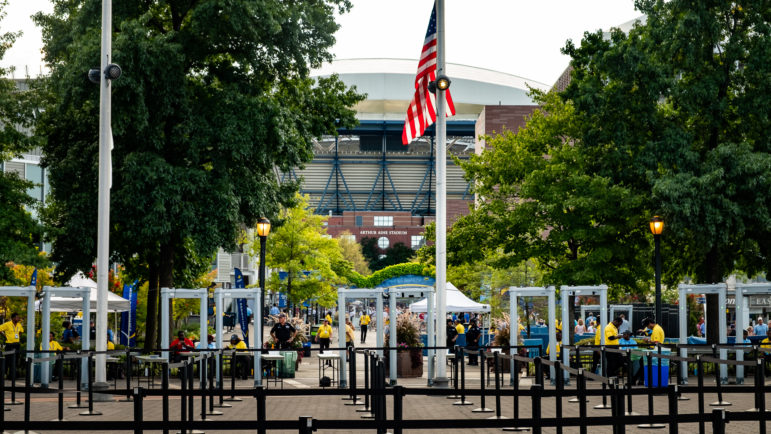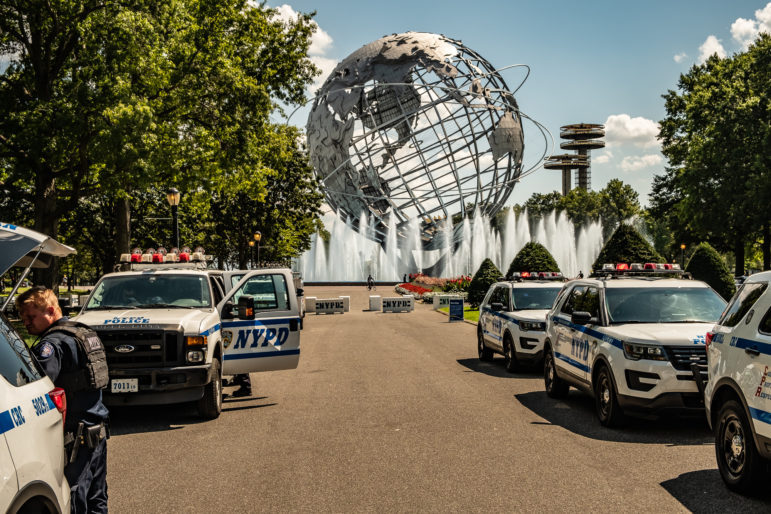
Adi Talwar
Steep ticket prices put the Open out of reach for working-class residents of nearby neighborhoods, and the self-contained nature of the tennis center means local businesses see little boost.
As the 138th annual U.S Open drew to a close and the thousands of spectators who make their yearly pilgrimage to Billie Jean King National Tennis Center in Flushing Meadows Corona Park ventured back home, some locals wished the games could have ended sooner.
“Screw the U.S Open!” says Michael a 68-year-old from Forest Hills. “They are really obnoxious in how they block the bike paths with their cars and the have security stationed everywhere. I really think that the Open doesn’t care about the people who live here.”
For Michael, like many Queens residents, Flushing Meadows is part of his daily bike riding routine. Yet for two weeks out of the year he’s annoyed when that routine is disrupted. “This is our park, and I use it everyday, and I hate that Open makes me feel like a stranger in it” he says.
Michael is far from alone in his sentiments. For years Queens-based activists, community leaders and civic organizations have been attempting to call attention to the plethora of issues that they struggle with every year that are directly related to the U.S Open. Those issues range from restricted access to parkland to underwhelming economic impact on the communities neighboring the Open. Community leaders believe that even though Queens hosts the U.S Open, the event has given the borough a cold shoulder.
A self-contained spectacle
“Over the years, I have seen very little effort by the USTA to encourage any local exploration in our communities,” says John Choe, executive director of the Greater Flushing Chamber of Commerce. “They make no effort to partner with us and honestly I don’t even think the U.S. Open sees the local community.”
In attempt to draw at least some of the fans from the Open outside its gates, the Flushing Chamber of Commerce is promoting a free walking tour during the two weeks of the Open. The tour is intended to take participants on a historical and culinary journey through the heart of Downtown Flushing, a foodie mecca, with the hope that they can be a boost to the local economy.
“We wanted to have the walking tour to showcase our community and because there is much effort by the USTA to separate our community from the open,” says Choe.”What’s the point of having this major sports event in the most diverse county in the country if they don’t celebrate that fact?”
For the most part, the Billie Jean King National Tennis Center functions as self-contained micro city segregated from the community around it. In about 30 minutes on an 7 express train, spectators are quickly shuttled from Grand Central right to the front of the Tennis Center gates. If spectators take the Long Island Railroad the trip is even quicker. After arriving at the Open, safely behind its gates, guests are encouraged to enjoy $15 Fuku spicy fried chicken sandwiches from celebrity chef David Chang’s restaurant or stroll through the Mercedes-Benz showrooms while they sip Honey Deuce cocktails from the Gray Goose bar. Everything one needs for comfort is within the confines of the tennis center. Fans have access to an abundant amount of choices regarding food, drinks, shops and banking.
With the median household income of attendees hovers at about $182,000 a year, Queens residents are struggling to make ends meet on a median annual household income of $56,406In fact, very little about the Open is marketed as an event for the benefit or enjoyment of working-class residents of Queens. Few locals can afford to shell out the $70 grounds pass for the first day of the tournament, let alone afford the $1,045 cost of the the men’s finals ticket.
In fact many of those who attend the Open aren’t even New Yorkers. Of the 691,143 fans who attended last years Open, 43 percent of them came from outside the New York City metro area and 19 percent came from overseas. This in stark contrast with the diverse demographic makeup of the surrounding communities. In the surrounding neighborhoods like Jackson Heights, Corona, East Elmhurst and Flushing , nearly 75 percent of of residents are people of color and 40 percent of them are living below the poverty line. In the predominantly immigrant neighborhoods of Elmhurst and Corona, 51 percent of children have obesity, the highest rate in the entire city.
The Green Zone?

Adi Talwar
Heavy security and intense vehicle usage make the Open an intrusive presence in one of the city’s best-loved parks.
Last year alone, the Open took in $350 million in revenue, making it one of the most profitable and largest sports events in the world. Choe says that from the Chambers perspective, Flushing sees very little economic impact from the Open.
“It’s a self-contained paradise for the one percent,” Choe says. ” It kind of reminds me like the Green Zone in Iraq.”
Don Capalbi, president of the Queensboro Hill Flushing Civic Association, would agree. “The U.S Open displays so much economic disparity while they turn Flushing Meadows into a militarized camp,” he tells City Limits.
One of the local casualties of the increased security in Flushing Meadows is the operating hours of the Queens Museum of Art ,which sits directly across from the iconic Unisphere. Citing the increased security presence in the park, the museum has elected to close its doors for the duration of the Open. Disruptions like this, however brief they may seem, can greatly disrupt local park goers’ quality of life.
Capalbi suggests that part of the problem is that the Open isn’t accountable to anyone. “The U.S Open is heavily subsidized by the taxpayers. We pay for all the police overtime and security. Yet there is a complete lack of accountability of how it’s being constructed in terms of economic impact,” he says.
What the USTA does like to promote is how much of a economic boon the Open is to the city’s economy. Citing a 2012 study, the USTA claims to generate $750 million in direct economic impact for New York City annually.
Nevertheless, there is scant evidence that can attest if any of that money is trickling down to Queens. “Despite being located in Queens, the USTA gives no specific economic analysis for the general economic impact it has on the borough. All of the statistics they publish mention the revenues or economic value of the NTC and the U.S. Open for New York City as a whole, or for New York State,” says Theo Oshiro, of Make the Road NY and author of a 2013 report on the negative impact of the U.S Open on Queens. “The USTA points out that during the U.S. Open, 16 percent of the City’s hotel occupancy is connected to the event. However, it does not say how much of that economic value goes to Queens.”
According to representatives from the Queens Economic Development Council, the only industries in Queens that do see a direct economic impact are the nearby airports and hotels.
When asked about the U.S Open’s direct economic impact in Queens, the USTA was unable to comment at the time of publication.
An alleged lack of accountability and transparency seem to be a common gripe about the Open among residents and community leaders. Many of those issues date back to 1993 in the deal the city made with the USTA when they were rumored to be planning to move to San Diego during the waning days of the Dinkins administration.
Fearing the loss of the major sports event and seeing an opportunity to cement his legacy, Dinkins signed a 99-year lease to expand the National Tennis Center (NTC) in Flushing Meadows from 21.6 acres to approximately 42.2 acres on public parkland. As part of the lease agreement, the USTA is required to pay the city about $500,000 a year in rent, and about $2 million a year in percentages from its projected $350 million in revenue.
But because the NTC is still registered by the state as parkland they pay no property taxes. Additionally, the city has issued $322,025,000 in City Bonds to finance USTA’s work on expanding the NTC, according to Make the Road. The bonds are completely financed by the city and the USTA has no obligation to repay the bonds.
In exchange for economic incentives form the city the USTA promised to replace the park land that was lost with new parkland.Instead of acquiring parkland at asite near by, the USTA purchased 24 acre Powell’s Cove Park in Whitestone, Queens. Of the 24 acres, only 7 acres are above ground with the other 17 acres comprising of underwater marshland. To make matters worse, the NTC’s facilities are hardly accessible to the public during the rest of the year. Court rental rates at the NTC start at $22 an hour and increase to $66 an hour during peak hours. Those rates are far more expensive than other courts on public land.
Nor does the center look inviting to newcomers. . “The USTA site is not ‘open to the public’,”says Oshiro in his report. ” It has 8 foot high steel gates around the perimeter that are padlocked to keep the community out of the facility.”
To its credit, for the past six years the USTA has made more of a proactive attempt to try to boost tourism in and around Queens by partnering with Queens Tourism Council and the Queens Chamber of Commerce in operating a Queens Tourism kiosk at the event. The kiosk mission is to give spectors information about local restaurants, hotels, and cultural venues they could enjoy while they are in Queens. Whether or not the kiosk is helping boost tourism in Queens isn’t known.
“Undoubtedly, the U.S Open is positive for the city,” says Choe. “We just wish the USTA was as involved in promoting the vibrancy of our communities as we believe they should be.”









3 thoughts on “The U.S. Open is Over. Did Queens Benefit?”
These big name projects “promise” the world only to renege when they get their foot in the door!
The officials are responsible for letting us down don’t forget Julissa ferreras allowing the new Usys stadium and managing the city budgets turning blind eye. Her former aide Cruz is curiously now in office in the area and Jose peralta who hasn’t done anything to help this. The cards we are dealt
I’ve lived within walking distance of the Open for my entire life, and this was my 33rd consecutive year attending it. If one wants to attend, one can – the ticket prices are lower than most concerts and Broadway plays. Furthermore, the eliminations the week before the tournament are free, as is the second Thursday of the main tournament itself. The tournament brings people to Queens who might never have thought of going. A small number of local restaurants are represented at the food court, and, as was noted in the article, hotels throughout the borough see sharp spikes in occupancy. In addition, this first class facility is a Parks Department site for most of the year, offering special programs as well as paid court time. My father, for example, went to the Senior program for years.
Disruption of a small number of bike paths (within a park with tons of others) and a two-week museum closure are small prices to pay for having an internationally prominent event in our borough.